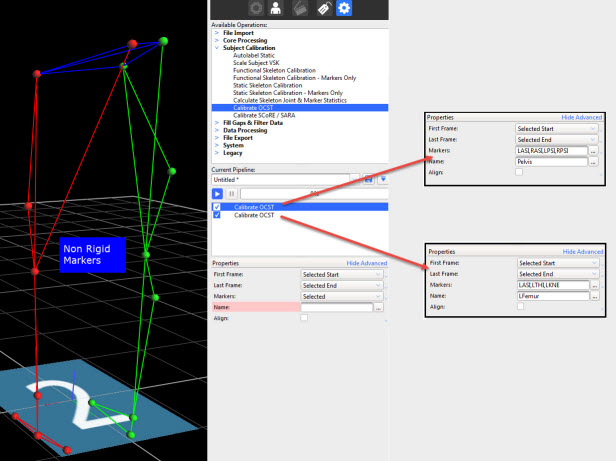OCST is a mathematical approach that finds the average or common shape for selected sets of marker (3 or more). It enables a non rigid cluster (skin-based) to be described as if it were truly rigid.
Important: Although marker clusters that are attached to a truly rigid base do not necessarily require OSCT processing to provide rigidity, if you want to include the supplied SCoRE and SARA pipeline operations as part of your workflow, use of the Calibrate OCST and Process OCST operations is recommended to provide the best possible results.
Related research can be found in the published papers:
Repeatability and reproducibility of OSSCA, a functional approach for assessing the kinematics of the lower limb. W.R. Taylor, E.I. Kornaropoulos, G.N. Duda, S. Kratzenstein, R.M. Ehrig, A. Arampatzis, M.O. Heller. publ. Gait & Posture 32 (2010) 231–236
To create a segment using OSCT:
1. Load the trial containing the markers whose positions are to be calculated using OCST. These markers will form the segments that will be used in SCoRE and SARA pipeline operations.
2. In the Pipeline tools pane, from the Subject Calibration pipeline operations, double-click the Calibrate OCST operation to add it to the current pipeline.
3. Click on Calibrate OCST and in the Properties pane ensure the required start and end frames, together with the required markers (at least three) are specified. To select the required markers, in the 3D Perspective view, CTRL+click or ALT+drag the markers (at least three per segment). If you have Markers set to Selected in the Properties pane, to check that you have selected the required markers:
a. In the Properties pane for Calibrate OCST, click the small arrow to the right of the Markers field and clear the Macro check box.

You can now see the selected marker names in the Markers field.

b. When you have made sure you have selected the required markers, re-select Macro again.
4. In the Name field, enter a name for the segment to be created by OCST.
5. To create the new segment, run the pipeline.
In the following example, OCST segments called Pelvis and LFemur are created.

The new OCST segment names (Pelvis and LFemur in the above example) can now be passed into SCoRE and SARA pipeline operations.
See also: